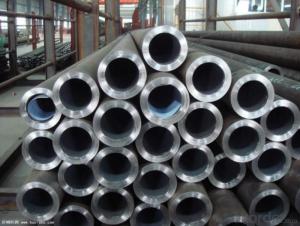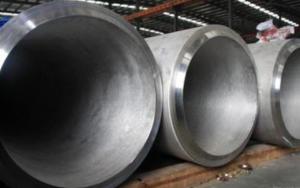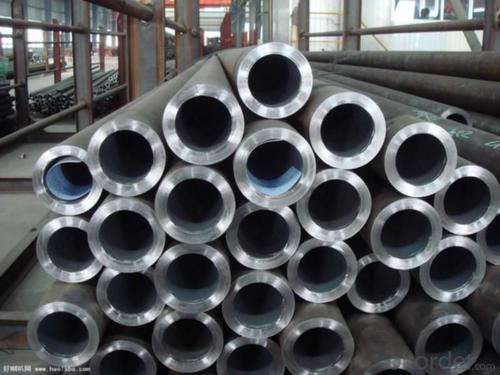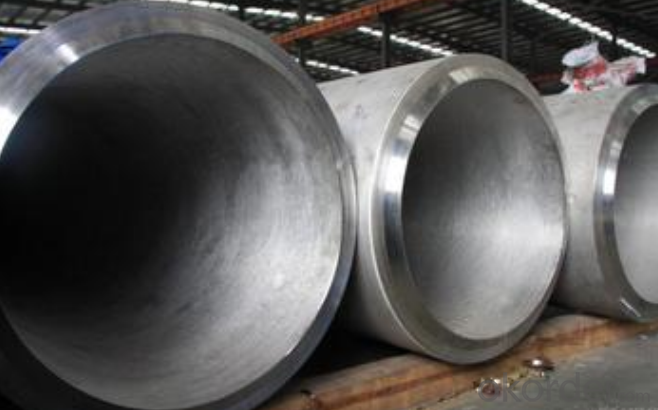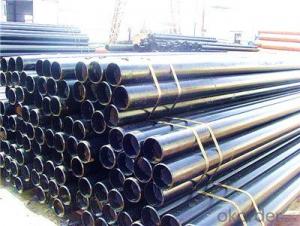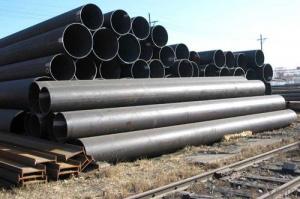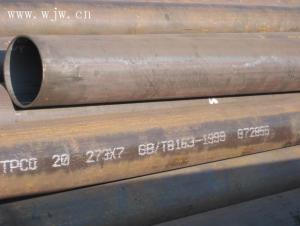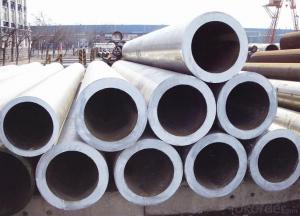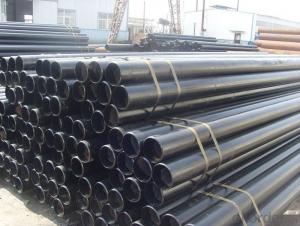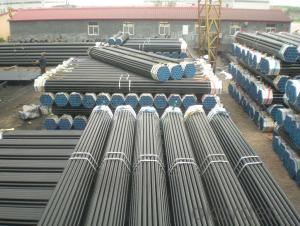Large Diameter Thick Wall Steel Pipe/Seamless Steel Pipe
- Loading Port:
- China Main Port
- Payment Terms:
- TT or LC
- Min Order Qty:
- 25 m.t.
- Supply Capability:
- 8000-10000 m.t./month
OKorder Service Pledge
OKorder Financial Service
You Might Also Like
1、Structure of Large Diameter Thick Wall Steel Pipe/Seamless Steel Pipe:
Seamless pipe is formed by drawing a solid billet over a piercing rod to create the hollow shell. As the manufacturing process does not include any welding, seamless pipes are perceived to be stronger and more reliable. Historically seamless pipe was regarded as withstanding pressure better than other types, and was often more easily available than welded pipe.
2、Main Features of the Large Diameter Thick Wall Steel Pipe/Seamless Steel Pipe
• High manufacturing accuracy
• High strength
• Small inertia resistance
• Strong heat dissipation ability
• Good visual effect
• Reasonable price
3、Large Diameter Thick Wall Steel Pipe/Seamless Steel Pipe Specification:
Standard | GB, DIN, ASTM ASTM A106-2006, ASTM A53-2007 |
Grade | 10#-45#, 16Mn 10#, 20#, 45#, 16Mn |
Thickness | 8 - 33 mm |
Section Shape | Round |
Outer Diameter | 133 - 219 mm |
Place of Origin | Shandong, China (Mainland) |
Secondary Or Not | Non-secondary |
Application | Hydraulic Pipe |
Technique | Cold Drawn |
Certification | API |
Surface Treatment | factory state or painted black |
Special Pipe | API Pipe |
Alloy Or Not | Non-alloy |
Length | 5-12M |
Outer Diameter | 21.3-610mm |
Grade | 20#, 45#, Q345, API J55, API K55, API L80, API N80, API P110, A53B |
Standard | ASME, ASTM |
1) Material:20#(ASTM A 106/A53 GRB.API5LGRB,GB),45#,16Mn,10#.
2) Specification range:OD:21.3-610mm,WT:6-70mm,length:6-12m or according to the requirement of clients.
3) Excutive standards:GB,ASME API5L.ASTM A 106/A53,Despite of the above standards,we can also supply seamless steel pipe with standard of DIN,JIS,and so on,and also develop new products according to the requirements of our clients!
4) Surface:black lacquered,varnish coating or galvanized.
5) Ends:Beveled or square cut,plastic capped,painted.
6) Packing:bundles wrapped with strong steel strip,seaworthy packing.
4、Packaging & Delivery
Packaging Details: | seaworthy package,bundles wrapped with strong steel strip |
Delivery Detail: | 15-30days after received 30%TT |
5、FAQ of Large Diameter Thick Wall Steel Pipe/Seamless Steel Pipe:
①How is the quality of your products?
Our products are manufactured strictly according to national and internaional standard, and we take a test
on every pipe before delivered out. If you want see our quality certifications and all kinds of testing report, please just ask us for it.
Guaranteed: If products’ quality don’t accord to discription as we give or the promise before you place order, we promise 100% refund.
②How about price?
Yes, we are factory and be able to give you lowest price below market one, and we have a policy that “ for saving time and absolutely honest business attitude, we quote as lowest as possible for any customer, and discount can be given according to quantity”,if you like bargain and factory price is not low enough as you think, just don’t waste your time.Please trust the quotation we would give you, it is professional one.
③Why should you chose us?
Chose happens because of quality, then price, We can give you both.Additionally, we can also offer professional products inquiry, products knowledge train(for agents), smooth goods delivery, exellent customer solution proposals.Our service formula: good quality+good price+good service=customer’s trust
SGS test is available, customer inspection before shipping is welcome, third party inspection is no problem.
6、Large Diameter Thick Wall Steel Pipe/Seamless Steel Pipe Images
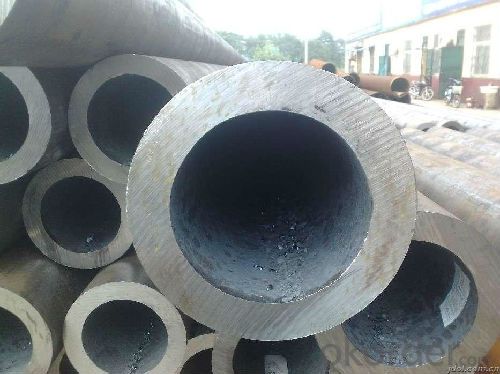
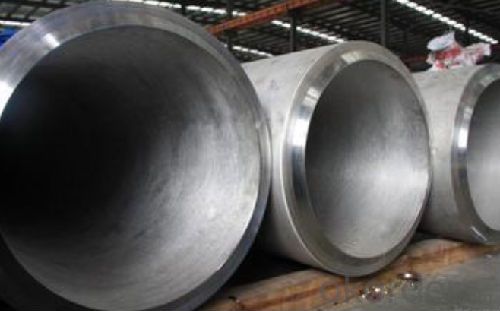
- Q: How are steel pipes threaded for connection?
- Steel pipes are threaded for connection using a process called threading, which involves cutting helical grooves into the pipe's surface. This is typically done using a machine called a pipe threading machine, which rotates the pipe while a cutting tool is held against it, creating the desired threading pattern. The threaded ends of the pipes can then be connected using fittings or couplings to create a secure and leak-proof joint.
- Q: Are steel tubes and round steel in weight or length when purchased?
- A large amount of words is calculated by weight, less is usually calculated. According to the length between the length and quality of a material is usually a scaling. Steel belongs to the section, with the length of valuation, according to the classification of wall thickness and diameter; round steel belongs to building materials, mostly for the amount of weighing per ton of valuation, a small amount of more than according to the length multiplied by the conversion ratio of weight to that theory. But the latter is the valuation of tons of steel products between the uneven thickness, with uniform proportion will produce larger price difference, so the general price of different manufacturers are not the same, mostly depends on the quality, to a certain extent is to balance the diameter difference.
- Q: What is the role of steel pipes in the mining and extraction of minerals?
- Steel pipes play a critical role in the mining and extraction of minerals as they are used for various applications throughout the process. These durable pipes are commonly employed to transport and distribute water, chemicals, and compressed air to different areas of the mine. Additionally, steel pipes are utilized in the construction of mine shafts, tunnels, and underground structures, providing stability and support. Their ability to withstand harsh conditions, resistance to corrosion, and high strength make steel pipes an indispensable component in the mining industry.
- Q: What is the difference between the stainless steel pipe welded pipe and seamless pipe?
- Grain size: usually, the grain size of the metal is related to the heat treatment temperature and the time at which the metal is kept at the same temperature. Therefore, the welded pipe and seamless tube annealing of the same grain size. If the minimum tube cold treatment, the grain size of the weld metal is smaller than the grain size, welding or grain size is the same.Strength: the strength of the pipeline in the composition of the alloy and alloy containing the same and the same heat treatment of seamless tube and seamed tube essentially consistent strength. After the tensile test and three-dimensional vibration test, tube tearing almost all occurred in the welding point or away from the heated area where. This is because there is little impurity in the weld and the nitrogen content is slightly higher, so the strength of the welded joint is better than that of other parts. However, the ASME Boiler and Pressure Vessel Association believes that the seamed tube can withstand 85% of the allowable pressure, which is mainly due to improved welding equipment data collection prior to today. The provisions of ASME 100% completely under license by ultrasonic testing pressure tube. Similarly, Europe and Asia also stipulates that can ensure the quality of welding performance by eddy current test tube, the eddy current testing is subject to legal procedures and licensed institutions. Trent's eddy current test was approved by the Swedish power division. ASME believes the current loss is relatively small, high-quality performance based on the seamed tube.
- Q: Are there specifications for scaffold steel pipe with 48mm * 3.2mm?
- Scaffold tubes are our name for materials used to build scaffolding, because most scaffolding uses tubular bamboo or steel tubing. Bamboo and other bamboo is for a long time in the use of the scaffolding tube, but due to lack of safety and durability, now only in rural and urban area construction is lagging behind some of the home building small building has been used. The modernization construction, the most commonly used type of scaffolding pipe is steel pipe, the scaffolding should not only meet the demand of workers, but also to meet the characteristics of scaffolding firm and durable, so tough hard steel is the best choice. The selected steel pipe generally requires smooth surface, no cracks, no bending, no rust, and meet the relevant national standards.
- Q: What are the different types of coatings used for internal lining of steel pipes?
- There are several types of coatings commonly used for the internal lining of steel pipes, including epoxy coatings, polyurethane coatings, cement mortar linings, and polyethylene linings. Each type of coating offers different benefits and is chosen based on factors such as the intended application, corrosion resistance requirements, and cost-effectiveness.
- Q: What are the different standards for steel pipes?
- There are several different standards for steel pipes, including ASTM (American Society for Testing and Materials), API (American Petroleum Institute), and ASME (American Society of Mechanical Engineers). These standards specify the requirements for various aspects of steel pipes, such as their dimensions, chemical composition, mechanical properties, and testing procedures. These standards ensure that steel pipes meet the necessary quality and safety standards for their intended applications.
- Q: What are the factors to consider while selecting steel pipes for a project?
- When selecting steel pipes for a project, there are several important factors to consider. These factors include the material composition of the steel, the pipe dimensions, the intended application, the environmental conditions, and the budget. 1. Material Composition: The material composition of the steel pipes is crucial as it determines the pipes' strength, corrosion resistance, and durability. Common types of steel used for pipes include carbon steel, stainless steel, and alloy steel. Each type has its own set of properties and is suitable for different applications. 2. Pipe Dimensions: The dimensions of the steel pipes, such as diameter and wall thickness, should be carefully considered. The pipe dimensions must be compatible with the project requirements and the system in which the pipes will be installed. It is essential to ensure that the selected pipes can handle the required flow rates and pressures. 3. Intended Application: The specific application of the steel pipes should be thoroughly assessed. Different projects may require pipes with varying characteristics, such as heat resistance, pressure resistance, or the ability to transport specific substances like gas, oil, or water. Understanding the application requirements will help in choosing the appropriate type of steel pipes. 4. Environmental Conditions: The environmental conditions in which the pipes will be installed must be evaluated. Factors such as temperature variations, exposure to moisture, corrosive substances, and external pressures should be taken into account. For instance, if the project involves underground installation or exposure to corrosive chemicals, corrosion-resistant steel pipes may be necessary. 5. Budget: The budget available for the project is also an important factor to consider. The cost of steel pipes can vary depending on their material composition, dimensions, and additional features. It is crucial to strike a balance between the project requirements and the available budget to ensure cost-effectiveness without compromising the quality and performance of the pipes. In conclusion, when selecting steel pipes for a project, it is important to consider factors such as the material composition, pipe dimensions, intended application, environmental conditions, and budget. By carefully evaluating these factors, one can choose the most suitable steel pipes that meet the project requirements and ensure long-term performance and durability.
- Q: Where is a steel pipe casing usually used?
- The casing, usually used in the basement construction, to protect the pipeline or convenient pipeline installation hoops.
- Q: Can steel pipes be used for structural purposes?
- Yes, steel pipes can be used for structural purposes.
Send your message to us
Large Diameter Thick Wall Steel Pipe/Seamless Steel Pipe
- Loading Port:
- China Main Port
- Payment Terms:
- TT or LC
- Min Order Qty:
- 25 m.t.
- Supply Capability:
- 8000-10000 m.t./month
OKorder Service Pledge
OKorder Financial Service
Similar products
Hot products
Hot Searches
Related keywords
